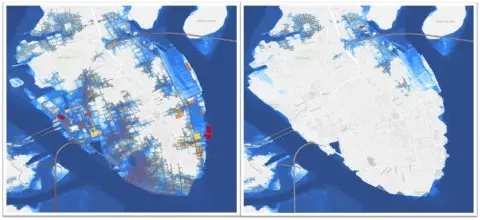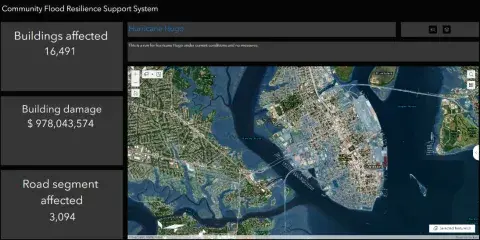When Hurricane Ida made landfall in Louisiana in August 2021, it was classified as a Category 4 storm with 150 mph winds, a storm surge that measured at more than five feet in New Orleans and 10 feet in Grand Isle, and rainfall of more than 15 inches. Inland flooding from the rain, combined with overflowing waterways and storm-surge flooding, resulted in a compound-flood event.
In 2021, extreme flooding from rain affected residents across the United States, causing property damage and loss of life. These extreme weather events are becoming all too common. In fact, a recent United Nations report—Climate Change 2021—found that heavy rain events are likely to become more intense and frequent, resulting in an increase in severe flooding events around the globe.

Preparing for and responding to climate change is a priority for the Department of Homeland Security (DHS), with Secretary Alejandro Mayorkas announcing earlier this year the creation of a Climate Change Action Group to drive the Department’s cross-functional efforts. And as DHS’ research and development arm, the Science and Technology Directorate (S&T) is developing resilience tools and resources to help communities and first responders prepare for the effects of climate change.
Preparing for and responding to climate change is a priority for the Department of Homeland Security (DHS), with Secretary Alejandro Mayorkas announcing earlier this year the creation of a Climate Change Action Group to drive the department’s cross-functional efforts. And as DHS’ research and development arm, the Science and Technology Directorate (S&T) is developing resilience tools and resources to help communities and first responders prepare for the effects of climate change.
Community-Oriented Flood Risk Planning in Coastal Communities
South Carolina has had its share of historic weather events that caused severe flooding. In October 2016, Hurricane Matthew was a Category 1 storm when it reached the state and left overwhelming flooding in its wake from storm surge, heavy rainfall, and overflowing rivers. In September 2017, Hurricane Irma, one of the strongest hurricanes recorded in the Atlantic Ocean, caused extensive destruction in the Caribbean and southeastern U.S. Irma made landfall in Florida as a Category 3 storm, and while it had weakened into a tropical storm when it moved onto Georgia and South Carolina, it brought significant storm-surge flooding and wind gusts, tornadoes, flooding rainfall, and river flooding. When an area is overcome by multiple sources of flooding at once, it becomes a compound-flood event.
S&T partnered with Deltares USA to address the risks that come with these type of events, developing a community-oriented, flood-hazard modeling and impact assessment decision support tool using open-source data, models and software. S&T and Deltares are integrating a suite of open-source tools the company developed into a Community Flood Resilience Support System (CFRSS) that can help communities make more informed decisions around flood risks and climate mitigations. CFRSS models flooding and damages caused by the combined effects of tides, storm surges, inundating precipitation, and river discharge to enhance understanding and the ability to address vulnerability to compound events.
S&T is working with Deltares because of its robust open-source software and scientifically validated models, and the company’s practitioner-driven focus will ensure that the tools are useful to end users. Training materials also are being developed so other communities can learn to leverage the technology as well.
“Our partnership with Deltares delivers a technology that bridges multiple flood types and the expertise of local stakeholders has helped hone the software to make it an effective community planning tool,” said Dr. David Alexander, S&T senior science advisor for resilience. “Additionally, users can play around with flood abatement settings, like adding flood walls or pumps or raising structures, to see how those would impact potential flood areas.”
Working with Local Experts
S&T and Deltares selected Charleston, South Carolina, as the CFRSS testbed since it provided ideal conditions and has experienced compound flooding. The city has dealt with coastal flooding caused by surges and tides, as well as from hurricanes; it has experienced inland flooding from heavy precipitation and river flooding; and it has faced flash floods caused by the changing landscape of a developing area. With all these flood-risk factors, Charleston was an optimal location for testing and applying the CFRSS system.
In addition, S&T and Deltares are taking advantage of existing research relationships in Charleston, including with the National Oceanographic and Atmospheric Administration’s (NOAA) Office for Coastal Management and the U.S. Army Corps of Engineers, which already has a coastal storm risk management study underway with the city. The CFRSS pilot with Charleston will include a hands-on training demonstration, with community partners participating. This training is also an opportunity to test the latest CFRSS version. Findings will be shared at the Association of State Floodplain Management (ASFPM) 46th Annual Conference in May.
While Charleston is fortunate to have high-quality model input data, CFRSS is designed to allow user communities to leverage national open-data sources. Communities without site-specific or high-precision data can use general data from sources like NOAA to produce a risk assessment that is useful and insightful.

“Charleston, like many coastal communities, has experienced a rapid increase in tidal flooding and extreme weather events over the past 20 years,” explained Dale Morris, Charleston’s Chief Resilience Officer. “With two-to-four feet of sea level rise predicted over the next 50 years and the increasing and compounding threat from rain and storm surge, the city needs a planning tool to help decision makers and stakeholders explore vulnerabilities, risks and opportunities under different scenarios, as well as the comparative benefits of mitigation actions. This modeling tool will enable us to quickly sandbox specific threats and identify different adaptation pathways the City must explore.”

A leading project goal is to bring in many stakeholders to participate and strengthen Charleston’s collaborations with other communities across the country. By sharing software, risk data and the program’s findings, CFRSS will help Charleston and other community stakeholders move forward with their larger resilience planning efforts.
Building Resilience in Flood and Infrastructure Planning
CFRSS will allow communities to explore how their specific flood risks change as future conditions, like sea levels, storm frequencies and population growth, change. It also will allow users to test different measures and visualize the effectiveness of these measures on flooding and impacts. CFRSS makes it easy for users to explore scenarios, like the impact of a proposed infrastructure project, against a projected sea level rise, without needing to modify any model input. CFRSS does that work for the user automatically. After running a scenario, the results automatically can be brought into a preformatted ArcGIS project for visualization or uploaded to an online viewer to facilitate sharing and communication.
CFRSS was designed to be transparent with base model input data—such as bathymetry, building replacement values or depth-damage functions— to make it accessible and flexible. A user can explore the base data used in the flood and damage models and if a community has new or more accurate model input data that information can be easily updated in the system. Furthermore, when CFRSS simulates a scenario by automatically changing model input data, the modified model input data also is accessible so a user can explore how a change—like a population growth projection—is represented in the model.
Understanding and planning for compound-flood events with tools like CFRSS will help communities mitigate risk and improve climate resilience, saving lives and property. The real-world results achieved through the testing program in Charleston will be a guide for other CFRSS users to better understand and prepare for compound-flood events. The project team will use the pilot findings to update the modeling software and look forward to promoting the tool at the ASFPM Conference, where resource links will also be available to share.
More about S&T’s work related to disaster resilience can be found on our Community and Infrastructure Resilience research portfolio page. For related media requests, please contact STMedia@hq.dhs.gov.
